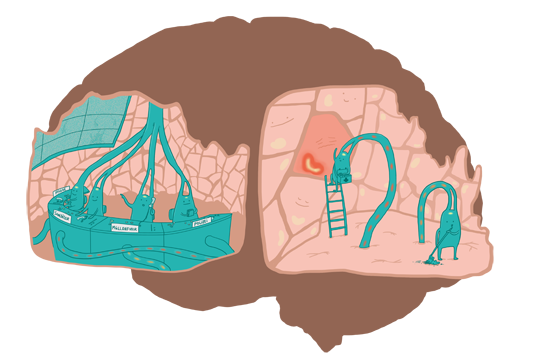Police, paramedics, garbage disposal
Freiburg, Mar 31, 2017
Microglial cells fulfill important tasks in almost all illnesses and disorders of the brain, as well as in its growth and maintenance. They are the brain’s building supervisors, police, nurses, paramedics, and garbage disposal. An international team of researchers wants to investigate the properties of microglial cells.

Microglial cells are first on the scene to fix the damage to a neural network. Marco Prinz calls them “The brain’s immune system.” Illustration: Svenja Kirsch
Beware: Something is feeling its way through your brain. It is the tentacles of microglial cells, which divide the brain up into territories. Each microglial cell guards its own little empire of neurons. With fine tentacles which stretch out and contract these guard cells are constantly pacing the beat of their neuro-networks. Are communications working right? Are the cells healthy? If an infection is spreading or something else goes wrong, the guard cells take action. “They are the brain’s immune system,” says Professor Marco Prinz, medical director of the Institute of Neuropathology at the Freiburg University Medical Center.
Prinz is the spokesman of the new transregional collaborative research center (SFB) NeuroMac. Freiburg is coordinating this research effort to investigate the properties of microglial cells. They fulfill important tasks in almost all illnesses and disorders of the brain, as well as in its growth and maintenance. They are the brain’s building supervisors, police, nurses, paramedics, and garbage disposal.
Getting an appetite for Alzheimer's
“In a healthy brain microglial cells even feed the cells,” Prinz says. Everything has to be shipshape in a microglial cell’s territory. Sometimes that means doing more than stretching out a tentacle. When things get rough, the entire cell moves to the troublespot and divides, creating an army of identical guard cells. They gobble up pathogens, dying cell parts and proteins which get into the brain via bleeding or are created by multiple sclerosis and other inflammatory processes, or which form plaques similar to those of Alzheimer's disease.
Unfortunately, microglial cells can get enough. After a few weeks, they tire of eating Alzheimer’s plaques and other undesirable material. “The cells are exhausted and aged,” Prinz explains. He is testing ways of replacing the population, for instance by replacing the bone marrow where the microglial cells can grow. The 46 year old believes that fresh microglial cells eat up far more Alzheimer plaques than older ones and could – maybe – heal sufferers. But he says it is too soon to get our hopes up: “That is still a far-off goal.”
Nutrition is crucial
In adult brains microglial cells coordinate reconstruction, and in embryo brains they supervise development. They encourage young neurons to form functional networks. Faulty construction of the brain can lead to disorders such as autism and schizophrenia. Is it just a supervisor’s mistake? “We don’t know the cause,” Prinz says. Yet severe viral infections during pregnancy raise the risk of such developmental illnesses – and alter the shape and function of the microglial cells. For example, they are bigger and look deformed in mice with no intestinal flora. The animals sometimes behave oddly.

Marco Prinz is the spokesman of the new transregional collaborative research center.
Photo: Private
Prinz believes that nutrition plays a role in the risk of developing autism or Alzheimer’s. Because food determines which bacteria flourish in the gut. “We replace certain bacterial strains and see what happens,” Prinz says. He aims to discover which types are good, which are bad, and what signals gut bacteria send to the brain. Researchers are testing various bacterial products to find out if they can be used as messenger molecules.
4.9 million for Freiburg
Many exciting findings and many unanswered questions. It’s hoped some of them will be answered by the SFB/Transregio 167: Development, function and potential of myeloid cells in the central nervous system (NeuroMac). Along with the experts from several University of Freiburg institutes and the Medical Center, researchers at Berlin’s Charité and Max Delbrück Center for Molecular Medicine and scientists at Israel’s Weizmann Institute of Science in Rehovot are investigating what makes microglial cells tick. They will receive nearly 10.9 million euros from 2017 to 2020. Some 4.9 million of that will come to Freiburg.
The long-term goal is the development of new treatments for conditions such as Alzheimer’s, strokes, depression, and multiple sclerosis. But Marco Prinz is careful to dampen expectations: “I will be happy if we come up with a definite new approach to treatment.”
Jürgen Schickinger

